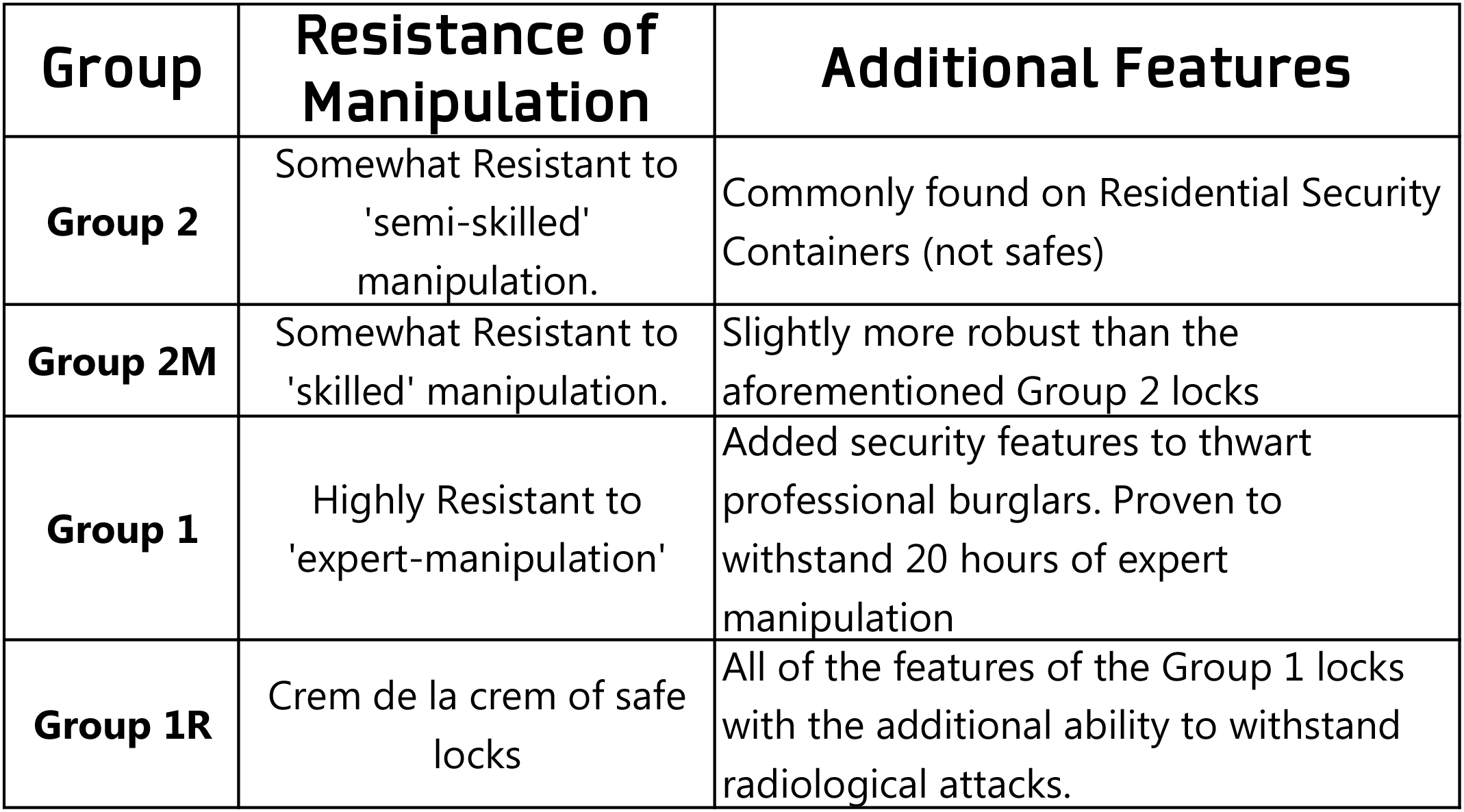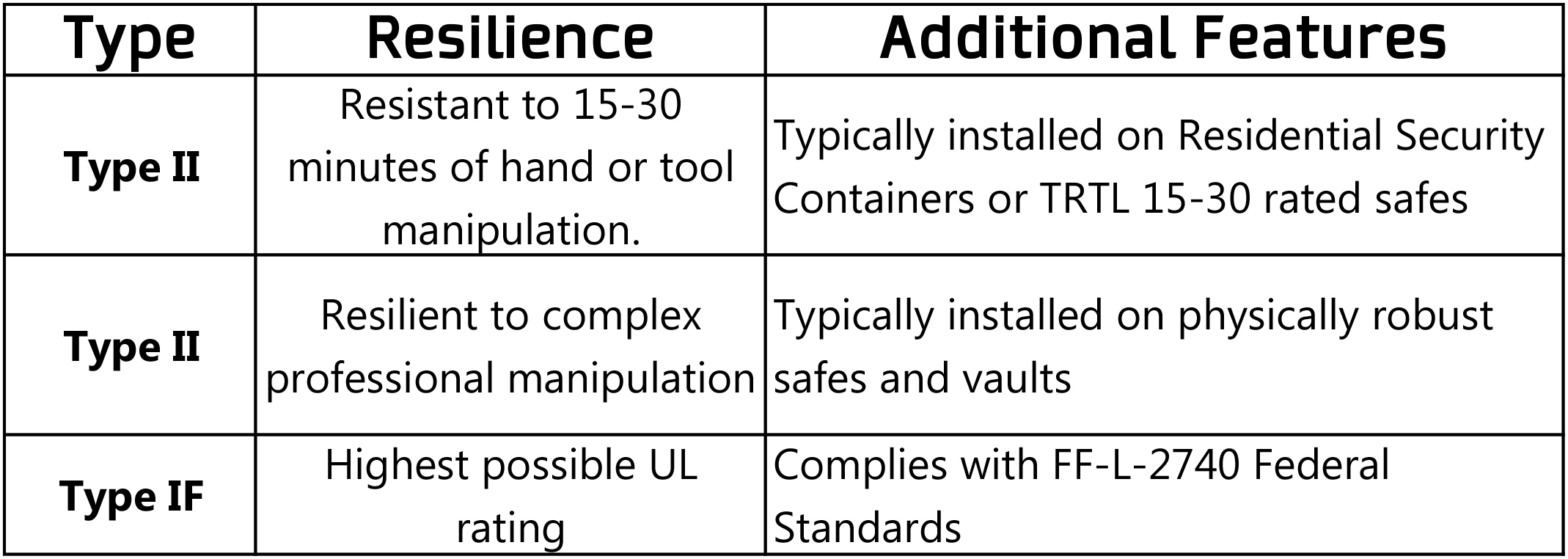Before we move on to the types of safe locks, if you missed Types of Safes – What’s the Difference last week and you aren’t familiar with the different types of safes skim through it before you read this one. Its ok – I’ll wait for you.
There’s a lot of useful information there, right? Remember when we discussed how the value of the safe’s contents drives the selection process for the type of safe? Well, the selection process for the type of lock is driven off of this value as well. Underwriter Laboratories (UL) has created an industry standard in ratings based upon the lock’s variety, resiliency, and complexity and encompasses the spectrum of different types of safe locks, but the most popular breeds are electronic and combination locks. So how are they rated, and how are they different?
Types of Safe Locks – Combination
Rating – Types of Safe Locks
Combination locks are rated based on their overall reliability and their resistance to manipulation. 
Combination locks were the first on the scene in the safe industry (Side bar – Harry Miller, the grandfather of LockNet’s CEO, invented the first manipulation-proof combination lock). While they are still frequently used on personal safes, you’re less likely to see them on a safe requiring higher security, with the exception of the groups 1 and 1R locks.
Combination locks aren’t typically a first choice in commercial settings for a number of reasons including the lack of security features that is often desired for high-value items, the time-consuming process of gaining (authorized) entry, and the fact that you almost always need a professional locksmith to change the combination. Facilities often need to quickly change the safe lock’s combination after a change in staffing – those locksmithing fees will add up rather quickly after a few of these staff changes!
Types of Safe Locks – Electronic
Rating – Types of Safe Locks
UL listed electronic locks must employ relocker and have, at the minimum, one million different possible combinations – yes, you read that correctly 1 million.
Electronic locks have become the standard safe lock of choice for the commercial industry. Access is granted by entering a code on the safe lock’s keypad; the quick nature of electronic entry is no doubt one of the key drivers behind their popularity. While combination locks are a hindrance to code changes, electronic locks often allow users to have individual codes. This is ideal in commercial settings where there is moderate to high turnover. Someone leaves? No problem – just deactivate their code. Remaining employees and managers will still work.
Types of Safe Locks – Additional Electronic Lock Features
- Time Delay – used to limit the frequency of opening and to act as a theft deterrent. The delay can typically be set between 1 and 99 minutes.
- Time Delay Override/Armored Car Override – a specific code is set during the lock initialization that allows the lock to be opened by a forced override during a time delay.
- Opening Windows – similar to a time delay, setting opening windows takes the control of opening a step further. Any attempted opening outside of the pre-set time frames are blocked and ignored by the lock. Time frames are customizable, some common utilizations include minutes or seconds following a time delay, or a specific time of day.
- Wrong Try Penalty – also referred to as “penalty modes” this feature is available in most electronic locks to prevent an individual from running through various combinations quickly. Following the entry of a number of incorrect codes (the number of incorrect tries can be customized), the lock enters “penalty” or “lock out” mode. Depending on user settings and model, the lock may reset after a set time following the lock out and allow the same number of incorrect code entries, or may require the correct code be entered the first try to prevent re-entry of lockout mode.
- Dual Custody – this feature prevents a single user from owner the container, typically two entry codes are required for successful opening. Typically given to two separate individuals, dual codes assist in deterring internal theft. The credentials aren’t restricted to multiple codes, they could also include utilization of an electronic lock and a key lock, two separate locks or another method of controlling access.
- Audits – most electronic lock manufacturers offer products that allow audit trails to be pulled by authorized individuals with data reports including the number of times the safe was opened, the time of these openings, and the code used for entry. Loss Prevention departments often use these audit trails in internal theft investigations or determining extraction times.
- Duress Mode – an operating code is entered along with a number or series of number and through the location’s security system or burglar alarm, alerts law enforcement of a robbery in progress. This feature only works when integrated with the alarm system; upon entry of the duress code, the lock is released and the container opened.
- Ability to Integrate with a Facility’s Access Control System – allows the ability to interface with the location’s existing access control and alarm system. This feature allows access to audit data in real time, increasing the visibility of who is accessing the safe. Many times this feature will operate in conjunction with the camera in the same room or office as the safe.
If you select an electronic lock for your facility or home, it’s important to remember that a bit more upkeep is required– they are electronic after all. At a minimum, remember to change the batteries to ensure proper performance, change the code to maintain the highest level of security, and if you happen to forget the combination, call your service provider or manufacturer of the safe lock – they can usually walk you through the process of resetting the code (after you’ve proven your identity!)
What types of safe locks are you using at your facilities? Have you had greater success with specific types of safe locks in achieving your security goals? Has the resilience of your safe or safe lock been put to the test? How did it stand up to the test? Let us know in the comments, or you can find us in the social media world of Facebook | Twitter | LinkedIn | Google+
Google
